Monkeypox Skin Lesion Dataset
Home » Dataset Download » Monkeypox Skin Lesion Dataset
Monkeypox Skin Lesion Dataset
Datasets
Monkeypox Skin Lesion Dataset
File
Monkeypox Skin Lesion
Use Case
Monkeypox Skin Lesion
Description
Monkeypox Skin Lesion Dataset (MSLD) provides a comprehensive collection of images to aid in the early diagnosis of monkeypox. This dataset includes images of monkeypox, chickenpox, and measles, enhanced with data augmentation techniques for accurate classification.

Description:
The recent outbreak of monkeypox has emerge as a significant global healthcare concern, rapidly spreading across more than 65 countries. Early diagnosis is crucial to curtail its spread. However, the availability of confirmatory Polymerase Chain Reaction (PCR) tests and other biochemical assays is limit. In this context, computer-aided identification of monkeypox from skin lesion images offers a valuable solution. Currently, no such datasets exist. Therefore, the “Monkeypox Skin Lesion Dataset (MSLD)” has been created by gathering and processing images through web scraping from news portals, websites, and publicly accessible case reports.
Download Dataset
Objective
The primary goal of the “Monkeypox Skin Lesion Dataset” is to distinguish monkeypox cases from similar non-monkeypox cases. In addition to the ‘Monkeypox’ class, the dataset includes images of skin lesions from ‘Chickenpox’ and ‘Measles’ under a class name ‘Others’, facilitating binary classification.
Content
The dataset comprises three folders:
- Original Images: This folder contains 228 images in total, with 102 images belonging to the ‘Monkeypox’ class and the remaining 126 images representing the ‘Others’ class (non-monkeypox cases such as chickenpox and measles).
- Augmented Images: To enhance the classification task, various data augmentation techniques such as rotation, translation, reflection, shear, hue, saturation, contrast, brightness jitter, noise addition, and scaling have been applied using MATLAB R2020a.
- Although these augmentations can be perform using ImageGenerator or other image augmentors, we provide the augment images to ensure reproducibility. Post-augmentation, the number of images increase approximately 14-fold, resulting in 1428 images for the ‘Monkeypox’ class and 1764 images for the ‘Others’ class.
- Fold1: This folder contains one of the three-fold cross-validation datasets. To avoid bias in training, three-fold cross-validation was performed. The original images were split into training, validation, and test sets in an approximate ratio of 70:10:20, maintaining patient independence. Only the training and validation images were augment, while the test set contains only the original images. Users can use the folds directly or employ other algorithms to augment the original data.
Web Application
Given the rapid community transmission of monkeypox, a consumer-level software is necessary to raise awareness and prompt rapid action. We develop a user-friendly web application name Monkey Pox Detector using the open-source Streamlit framework, which utilizes our trained model to predict whether a user should see a specialist. The application provides prediction accuracy and will continue to improve with future updates, incorporating user data. The web app features a Flask core, allowing for cross-platform deployment in the future.
This dataset is sourced from Kaggle.
Contact Us

Quality Data Creation

Guaranteed TAT

ISO 9001:2015, ISO/IEC 27001:2013 Certified

HIPAA Compliance

GDPR Compliance

Compliance and Security
Let's Discuss your Data collection Requirement With Us
To get a detailed estimation of requirements please reach us.
